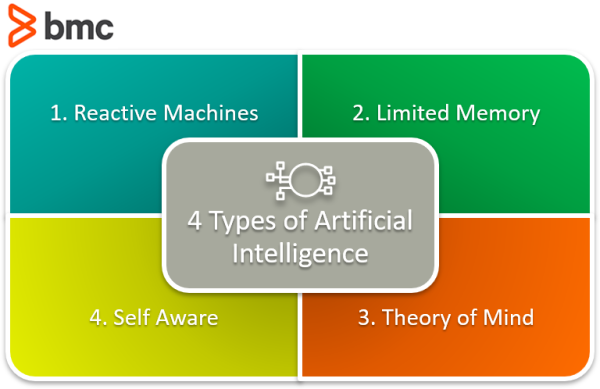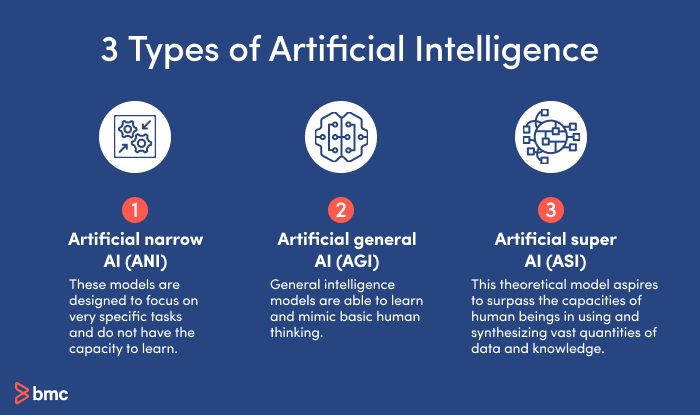Artificial intelligence (AI) has gone mainstream. We are experiencing an evolutionary leap forward in the technology and in its adoption and use. Once the exclusive domain of specialized technologists, now everyone is using it, from school children writing reports to employees using it for business applications. AI will soon have a role in nearly every corner of technology.
The pace of adoption and ongoing evolution of AI technology will only increase. As you track the trends, it is helpful to understand the various types of AI that are coming into common use.
What are the different types of AI?
The ways of organizing various approaches to AI are constantly evolving. In 2024, we can classify artificial intelligence into at least seven distinct types: three capabilities-based types and four functionality-based types that loosely correspond to Maslow’s hierarchy of needs. The simplest AI technologies match with the basic survival level of Maslow’s model. The most sophisticated levels of AI are self-aware, and match to the self-actualization level of that model.
The four functional types of AI are:
- Reactive Machines
- Limited Memory
- Theory of Mind
- Self-aware
The current state of AI technology has evolved past the first type of reactive machines. The third and fourth types currently exist only in theory. They represent the next stage of AI—development.
Tech-oriented specialists organize different types of AI models according to how the AI is used, what its capabilities are, and how it helps advance humanity.
The three types of AI based on capabilities are:
- Artificial narrow intelligence
- Artificial general intelligence
- Artificial super intelligence
4 main types of functionality-based AI

Here are overviews of the ways functionality-based AI is organized.
1. Reactive machine AI
Reactive machine AI performs basic operations and represents the simplest level of artificial intelligence. These types react to some input with some output. There is no learning that occurs.
Reactive machine AI is the first stage to any AI system. A machine learning algorithm that takes a human face as input and outputs a box around the face to identify it as a face is a simple, reactive machine AI. The model stores no inputs and performs no learning.
Static machine learning models are reactive machines. Their architecture is the simplest and they can be found on GitHub repos across the web. These models can be downloaded, traded, passed around, and loaded into a developer’s toolkit with ease.
Examples of reactive machine AI:
- IBM Deep Blue. Developed in 1997 to defeat chess champion Garry Kasparov, this brute-force AI demonstrated the capacity of the technology to handle complex tasks. It did not have memory or learning capacity.)
- Google AlphaGo. This breakthrough in evolution uses deep learning and neural networks to give the machine the capability to use intuition and strategic thinking to learn how to master the game of Go.
- Netflix Recommendations Engine. Rather than the academic exercise of playing games, this AI serves real customers in a real business, making programming recommendations that encourage more viewing and subscriber retention.
- Traffic management systems. These AI systems use real-time data and predictive algorithms to manage the flow of traffic, alleviating congestion, improving safety, and reducing emissions.
- Rule-based gaming AI. This technology learns and evolves according to player actions to create more challenging and enjoyable gameplay experiences.
Getting started with AIOps is easy. Manage escalating IT complexity with artificial intelligence for enterprise operations.›
2. Limited memory AI
Limited memory AI can store previous data, using that data to make better predictions. With limited memory AI, machine learning architecture becomes a little more complex. Every machine learning model requires limited memory to be created, but the model can get deployed as a reactive machine type.
There are three major kinds of machine learning models that achieve this limited memory type:
- Reinforcement learning. These models learn to make better predictions, through trial and error, to understand how to play games like Chess, Go, and DOTA2.
- Long Short Term Memory (LSTMs). The LSTM model uses past data to predict the next elements in a sequence, preferencing more recent information in the algorithm.
- Evolutionary Generative Adversarial Networks (E-GAN). The E-GAN model uses evolutionary algorithms to create a constantly improving learning process that allows the machine to explore options through a process of mutation and selection.
Limited memory AI examples:
- Self-driving cars. This AI uses algorithms that connect to sensors, cameras, and data in a vehicle to navigate roads, interpret signs and traffic signals, and avoid obstacles.
- Customer service chatbots. These models use natural language processing and machine learning to understand customer requests and respond in real-time to improve customer service.
- Smart home devices. This AI controls home systems like thermostats, lights, water heaters, window treatments, and security systems to optimize and automate homes for a personalized living space.
- Industrial robotics. AI can power the robots that work in assembly, quality inspection, materials handling, packaging, and more. They enhance productivity and safety, increasing speed and accuracy.
Limited memory AI types in practice
While every machine learning model is created using limited memory, they don’t always become that way when deployed.
Limited memory AI works in two ways:
- A team continuously trains a model on new data.
- The AI environment is built in a way where models are automatically trained and renewed based on model usage and behavior.
For machine learning infrastructure to sustain a limited memory AI type, the infrastructure requires machine learning to be built into its structure.
Active learning is increasingly more common in the machine learning lifecycle. The machine learning active learning cycle has six steps:
- Training data. A machine learning model must have data to train on.
- Build model. The model is created.
- Model predictions. The model makes predictions.
- Feedback. The model gets feedback on its prediction from human or environmental stimuli.
- Feedback becomes data. Feedback is submitted back into a data repository.
- Repeat. Continue to iterate on this cycle.
3. Theory of mind AI
Technology is now beginning to evolve theory of mind AI types. This type of AI begins to interact with the thoughts and emotions of humans.
Current models have a one-way relationship with AI. A user issues a command to a system like Alexa or Siri, and they respond. They do not respond to emotions, so If you angrily yell at Google Maps to take you another direction, it does not offer emotional support, calm you down with assurances, or offer to inform someone that you’ll be late. Instead, it continues to return the same traffic reports and ETAs that it had already shown and has no concern for your distress.
ChatGPT is getting closer to a theory of mind AI. If you thank it for its help, it will graciously accept the compliment and express an eagerness to help more. You can also tell it how frustrated you are, and it will appear to commiserate.
Fields of study tackling this issue include Artificial Emotional Intelligence and developments in the theory of Decision-Making. Michael Jordan presented some of his Decision-Making research at the May 13, 2020 event, The Future of ML and AI with Michael Jordan and Ion Stoica, and more coverage was presented at the ICLR 2020 conference.
4. Self-aware AI
In the not-too-distant future, AI will become self-aware. This kind of AI exists only as a concept and in science fiction stories.
The potential is immense. At the same time, however, we have reason to fear the consequences of this evolution. It is possible for a self-aware AI, independent of the best of human values, to become adversarial to humans, and people will likely have to negotiate terms with the entity created.
3 types of capability-based AI

1. Artificial narrow AI (ANI)
These models are designed to focus on very specific tasks and do not have the capacity to learn.
2. Artificial general AI (AGI)
General intelligence models are able to learn and mimic basic human thinking.
3. Artificial super AI (ASI)
This theoretical model aspires to surpass the capacities of human beings in using and synthesizing vast quantities of data and knowledge.
Are there other types of AI models?
The rapid evolution of AI technology naturally causes the propagation of additional names and classifications for types of AI models. Examples include:
- Generative AI. Generative means this AI creates new content, which could be text, images, music, and even new virtual worlds. There are various types of generative AI available now.
- Deep learning. This technology uses layers of neural networks to mimic how human minds work in order to extract complex patterns, recognize images, process natural language, and handle autonomous driving.
- Natural language processing (NLP). This type of AI understands and interprets human languages and is invaluable in translating text, tracking sentiment and meaning, and creating conversational interfaces that make machine communication with people feel natural.
- Weak vs. strong AI. Weak AI models are limited, basic technologies designed for specific tasks, while strong AI models are moving toward human-like thinking with the ability to learn and apply knowledge.
- Multimodal AI. These models capture, integrate, and process data in multiple formats from a variety of sources to synthesize an understanding of complex situations and perform various tasks, such as captioning an image, analyzing a video, and searching across media.
- Large language models (LLMs). Using deep learning and natural language processing, these AI models can summarize text or the spoken word, understand and answer questions, and perform translations. They bring cultural and contextual awareness to the work for increased accuracy.
The future of AI models
However you define and classify AI models, the technology is here to stay. AI holds the potential to transform human creativity and capabilities in nearly every industry, from healthcare to finance to education and beyond.
While the positives are obvious, AI technology creates ethical issues and concerns that can affect society as a whole, touching on privacy, bias, government regulation, and security, to name a few. While people fear job loss, AI also creates new kinds of jobs.
With the right care and controls, AI can help humans take on complex global challenges and improve the lives of millions.





